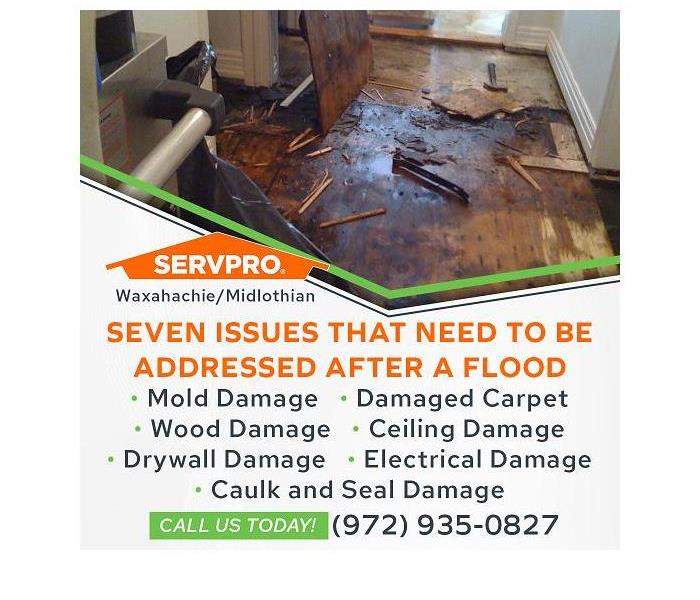Seven Secondary Water Damage Issues That Can Arise after Fire Damage
8/11/2022 (Permalink)
Blog Summary: SERVPRO of Waxahachie/Midlothian offers tips on dealing with advanced secondary water damage after a fire.
SERVPRO of Waxahachie/Midlothian specializes in water damage repair after water intrusion from a ruptured supply line, severe weather, or efforts from the fire department to extinguish a blaze by pumping thousands of gallons of water into a burning home or business. Secondary water damage presents serious issues that must be addressed. Failure to identify and resolve these issues can leave Red Oak, TX, homes unsafe and unfit for the family to live in.
After a Fire Has Been Extinguished
When the fire department arrives on the scene, the goal is to extinguish the fire as quickly as possible. A standard fire hose can deposit hundreds of gallons of water per minute into a burning home. The pumping pressure is between 800psi and 2000psi, which sprays water out of the nozzle at 70 miles per hour. Large amounts of water pumped under high pressure into the home will cause serious water damage issues that must be addressed immediately to prevent advanced secondary water damage.
Restoration after the Fire
Never enter a fire-damaged structure until the fire department declares that the site is safe. The utmost caution is advised. Portions of the floor and ceiling may be unstable, and wet or moist flooring increases the risk of a slip, trip, or fall injury. Surfaces and the air may be contaminated with VOCs, which can cause health effects. Even if the power is still on or the sun is shining, the interior of the home will be blackened by smoke and soot, making it difficult to navigate through the debris. Narrow hallways and stairs can be treacherous. Once the damage is inspected and assessed, a detailed and well-documented list of damages, repairs, and replacements must be compiled.
Hidden Water
Large quantities of water streaming into a home, as is the case with water from a fire hose, will soak everything in sight and much of the structure that is not readily visible such as behind walls, in ceilings, in the HVAC ductwork, and in the crawl space. If hidden water and moisture are not addressed, advanced secondary water damage can have a significant impact on the overall cost of cleanup and restoration.
Seven Issues That Need to Be Addressed after a Flood
These issues are common to structures experiencing a blaze extinguished by the fire department using high-pressure hoses to quickly deliver water to the flames. A small fire confined to a particular room such as the kitchen still requires much water to be thoroughly extinguished. A fire damage disaster, whether large or small, that also involves water intrusion is best left to trained, experienced, and well-equipped professionals. The scale of the disaster and the contaminants from the fire, smoke, and soot create a hazardous environment unsuitable for a DIY cleanup and restoration project.
1. Mold Damage
Mold thrives in a warm, moist, dark environment with lots of organic matter for food. A fire-damaged, water-soaked home is highly susceptible to mold infestation. Rapid removal of excess water and thorough drying are essential. Cleanup using EPA-approved cleaners follows the drying process. After the cleanup and restoration process is completed, regular inspections are necessary to spot and treat mold growth before an infestation occurs.
2. Damaged Carpet
Carpets retain moisture and toxins after a fire. If the floor covering is not quickly and properly dried and cleaned, pathogens in the wet carpet will make it unsalvageable.
3. Wood Damage
Wood is porous and readily soaks up water and moisture. Floor covering, substrate, studs, cabinets, doors, and furniture are prone to water damage. Efforts to dry out wood and wood products should receive immediate attention. Dehumidifiers and rapid spin fans effectively mitigate the damage, and moisture-detecting technology can confirm when the drying process has been successful.
4. Ceiling Damage
Water-damaged ceilings are risk hazards and should receive immediate attention. Areas that appear to be about to collapse should be secured or removed before anyone is injured or further damage is caused in the home should the ceiling collapse.
5. Drywall Damage
Drywall and sheetrock will bear the brunt of the water and fire damage. Severely damaged areas can be cut out and replaced. Drywall and sheetrock repair requires special tools and skills. Here is where a full-service cleanup and restoration team can help.
6. Caulk and Seal Damage
Standing water will weaken seals around appliances, toilets, and bathtubs. Cracked or loose seals can result in leaks both at the time of the fire and later down the road. Replace damaged seals and re-caulk where needed to prevent leaks after the cleanup and restoration.
7. Electrical Damage
Electronics, appliances, and the wiring behind the walls and in the electrical panel may have received extensive damage and pose a separate fire risk. Electronics, TVs, and some appliances can be dried and repaired. However, due to the fragile nature of the components, the drying and cleanup must be accomplished very quickly.
SERVPRO of Waxahachie/Midlothian is a full-service property damage cleanup and restoration company. They can manage the project from end to end, including all phases of restoration and replacement. The process starts when the team arrives on the scene to inspect and assess the damage. A detailed and well-documented estimate is prepared for the homeowner. The capable staff can handle the insurance claims process from start to finish.
For more details about fire and water damage restoration, contact SERVPRO of Waxahachie/Midlothian by calling (972) 935-0827 or emailing acarey@SERVPRO10932.com



 24/7 Emergency Service
24/7 Emergency Service
